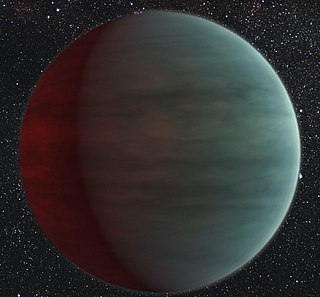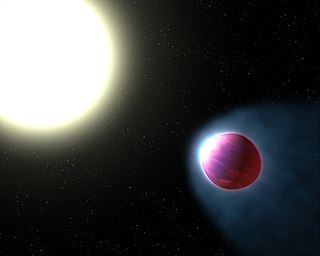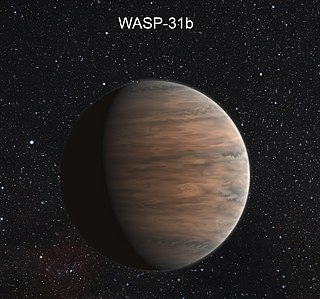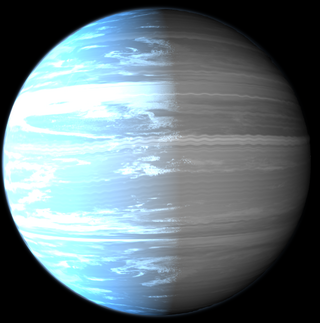
HD 209458 b is an exoplanet that orbits the solar analog HD 209458 in the constellation Pegasus, some 157 light-years from the Solar System. The radius of the planet's orbit is 0.047 AU, or one-eighth the radius of Mercury's orbit. This small radius results in a year that is 3.5 Earth-days long and an estimated surface temperature of about 1,000 °C. Its mass is 220 times that of Earth and its volume is some 2.5 times greater than that of Jupiter. The high mass and volume of HD 209458 b indicate that it is a gas giant.

Hot Jupiters are a class of gas giant exoplanets that are inferred to be physically similar to Jupiter but that have very short orbital periods. The close proximity to their stars and high surface-atmosphere temperatures resulted in their informal name "hot Jupiters".

HD 189733 b is an exoplanet in the constellation of Vulpecula approximately 64.5 light-years away from the Solar System. Astronomers in France discovered the planet orbiting the star HD 189733 on October 5, 2005, by observing its transit across the star's face. With a mass 11.2% higher than that of Jupiter and a radius 11.4% greater, HD 189733 b orbits its host star once every 2.2 days at an orbital speed of 152.0 kilometers per second, making it a hot Jupiter with poor prospects for extraterrestrial life.

WASP-4b is an exoplanet, specifically a hot Jupiter, approximately 891 light-years away in the constellation of Phoenix.

WASP-17b, officially named Ditsö̀, is an exoplanet in the constellation Scorpius that is orbiting the star WASP-17. Its discovery was announced on 11 August 2009. It is the first planet discovered to have a retrograde orbit, meaning it orbits in a direction counter to the rotation of its host star. This discovery challenged traditional planetary formation theory. In terms of diameter, WASP-17b is one of the largest exoplanets discovered and at half Jupiter's mass, this made it the most puffy planet known in 2010. On 3 December 2013, scientists working with the Hubble Space Telescope reported detecting water in the exoplanet's atmosphere.

WASP-18b is an exoplanet that is notable for having an orbital period of less than one day. It has a mass equal to 10 Jupiter masses, just below the boundary line between planets and brown dwarfs. Due to tidal deceleration, it is expected to spiral toward and eventually merge with its host star, WASP-18, in less than a million years. The planet is approximately 3.1 million km from its star, which is about 400 light-years from Earth. A team led by Coel Hellier, a professor of astrophysics at Keele University in England, discovered the exoplanet in 2009.
WASP-18 is a magnitude 9 star located 400 light-years away in the Phoenix constellation of the southern hemisphere. It has a mass of 1.29 solar masses.

WASP-19b, formally named Banksia, is an exoplanet, notable for possessing one of the shortest orbital periods of any known planetary body: 0.79 days or approximately 18.932 hours. It has a mass close to that of Jupiter, but by comparison has a much larger radius ; making it nearly the size of a low-mass star. It orbits the star WASP-19 in the Vela constellation. At the time of discovery it was the shortest period hot Jupiter discovered as planets with shorter orbital periods had a rocky, or metallic composition.
WASP-33b is an extrasolar planet orbiting the star HD 15082. It was the first planet discovered to orbit a Delta Scuti variable star. With a semimajor axis of 0.026 AU and a mass likely greater than Jupiter's, it belongs to the hot Jupiter class of planets.

WASP-43b, formally named Astrolábos, is a transiting planet in orbit around the young, active, and low-mass star WASP-43 in the constellation Sextans. The planet is a hot Jupiter with a mass twice that of Jupiter, but with a roughly equal radius. WASP-43b was flagged as a candidate by the SuperWASP program, before they conducted follow-ups using instruments at La Silla Observatory in Chile, which confirmed its existence and provided orbital and physical characteristics. The planet's discovery was published on April 14, 2011.

KELT-9b is an exoplanet and ultra-hot Jupiter that orbits the late B-type/early A-type star KELT-9, located about 670 light-years from Earth. Detected using the Kilodegree Extremely Little Telescope, the discovery of KELT-9b was announced in 2016. As of June 2017, it is the hottest known exoplanet.

WASP-121b, formally named Tylos, is an exoplanet orbiting the star WASP-121. WASP-121b is the first exoplanet found to contain water in an extrasolar planetary stratosphere. WASP-121b is in the constellation Puppis, and is about 858 light-years from Earth.
WASP-121, also known as CD-38 3220 and formally named Dilmun, is a magnitude 10.4 star located approximately 858 light-years away in the constellation Puppis. WASP-121 has a mass and radius similar to the Sun's. It hosts one known exoplanet.

WASP-31b is a low-density (puffy) "hot Jupiter" extrasolar planet orbiting the metal-poor dwarf star WASP-31. The exoplanet was discovered in 2010 by the WASP project. WASP-31b is in the constellation of Crater, and is about 1305 light-years from Earth.
WASP-104b is a hot Jupiter exoplanet that orbits the star WASP-104. It is considered to be one of the darkest exoplanets discovered. WASP-104b was discovered in 2014; according to a 2018 study at Keele University, the planet's dense atmosphere of potassium and sodium absorbs more than 97% of light it receives.

WASP-107b is a super-Neptune exoplanet that orbits the star WASP-107. It lies 200 light-years away from Earth in the constellation Virgo. Its discovery was announced in 2017 by a team led by D. R. Anderson via the WASP-South.

WASP-76b is an exoplanet classified as a Hot Jupiter. It is located in the constellation Pisces and orbits its host star, WASP-76, at a distance of approximately 0.033 AU. Its orbital period is approximately 1.8 days, and its mass is about 0.92 times that of Jupiter. The discovery of WASP-76b took place on October 21, 2013; as of 2022, it is the only known planet in the WASP-76 system. The equilibrium temperature of WASP-76b is estimated to be around 2,190 K, However, the measured daytime temperature is higher, reaching approximately 2,500 ± 200 K.
WASP-72 is the primary of a binary star system. It is an F7 class dwarf star, with an internal structure just on the verge of the Kraft break. It is orbited by a planet WASP-72b. The age of WASP-72 is younger than the Sun at 3.55±0.82 billion years.
WASP-80 is a K-type main-sequence star about 162 light-years away from Earth. The star's age is much younger than the Sun's at 1.352±0.222 billion years. WASP-80 could be similar to the Sun in concentration of heavy elements, although this measurement is highly uncertain.



















